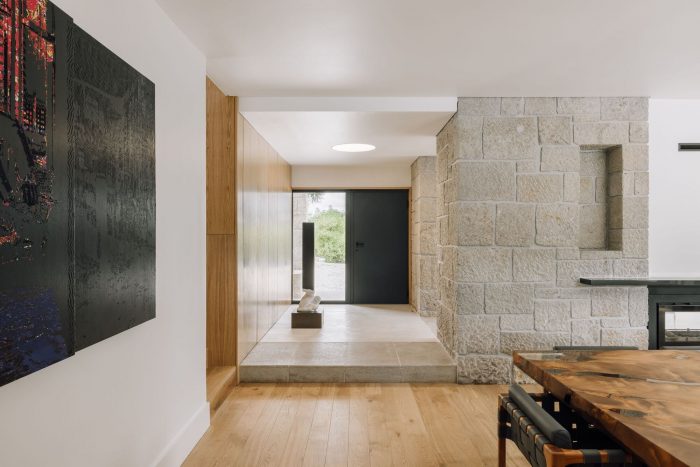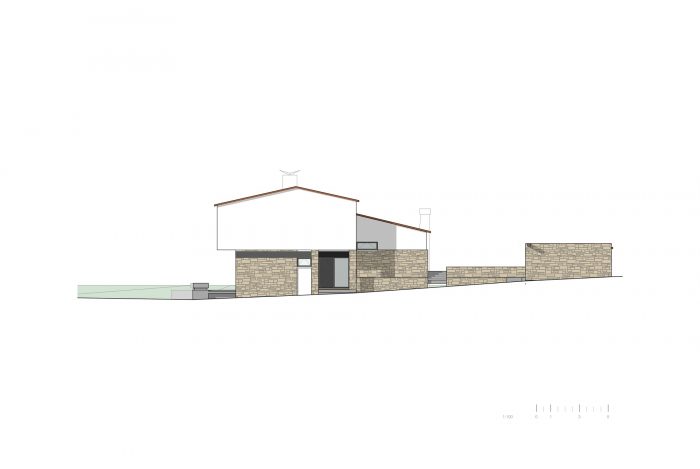翻新项目是一个为现有建筑带来新生命的机会,改变它的使用方式,更新它以适应当今的现代生活标准。有时,这样的工作是在一个一开始就没有或几乎没有(立即感知到的)建筑价值的项目上进行的,在其他情况下,翻新项目的对象可能是一个列名建筑或纪念碑,但在这两者之间,有数以百万计的、精心建造(和精心设计)的结构,都准备好了,等待着被重新鉴定。
A refurbishment project is an opportunity to bring a new life into an existing building, changing the way it is used and updating it to today’s modern standards of living. At times, such work is carried out on a project that to start with has little or no (immediately perceived) architectural value, in other cases, the object of the refurbishment project may be a listed building or a monument, but in between the two, there are millions, and millions of well built (and well designed) structures that are all ready and in waiting to be requalified.
Quinta da Joaninha就是这样一个项目,它最初设计于1960年,是一个具有现代感的住宅,当时葡萄牙政权还没有完全接受现代性。
Quinta da Joaninha was such a project, designed originally in 1960, this house was a home with a modern feel, at a time when modernity was not fully embraced by the Portuguese Regime.
在这个建筑中,我们首先提升了结构的热效率,在原有的空洞中注入了透气的隔热材料,创造了通往屋顶空隙的通道,并确保新的窗户和开口都被高热效率但又简约的窗户所取代。
Working with this building, we started by upgrading the thermal efficiency of the structure, by injecting breathable insulation into a pre-existing cavity, creating access to the roof void which again was fully insulated, and ensuring that new windows and openings were all replaced by high-thermal efficient, yet minimalist ones.
在外部,工程恢复了房子的正式外观,保留并突出了隐蔽的混凝土卷闸门外壳,使其具有特色,我们在立面上创造了三个新的开口,仔细放置,使其看起来与原始结构一致。这些新的开口给房子带来了变化,使其可以更直接地进入后花园,并增加了房子的光线和视角。
Externally, the work restored the house to its formal appearance, keeping and highlighting the concealed concrete roller shutter casings that give it its character, and we created three new openings in the façade, carefully placed so that they appeared in keeping with the original structure. These new openings brought change to the house making it possible to access the back garden more directly, and increasing the light and perspectives through the house.
在整体布局方面的手术干预是遵循的指导原则,以创造一个现代的和更开放的厨房,并有一个小酒窖/酒吧区,并重新组织卧室区,以确保房子将有一个现代的套房主卧室。关于它的材料,下层的特色石墙,也就是起居室和餐厅所在的地方,被略微缩小,并与天然橡木镶板相平衡,这为楼梯、地板以及加入设计的简洁的现代门创造了主题。
Surgical intervention in terms of the overall layout was the guiding principle followed to create a modern and more open kitchen with a small wine cellar/bar area and reorganize the bedroom area to ensure the house would have a modern en-suite master bedroom. Regarding its materiality, the feature stone walls of the lower level, where the living and dining rooms are, were slightly reduced and balanced with natural oak paneling, which created the motto for the staircase, floors, as well as the clean modern doors which were added to the design.
有三个浴室(加上一个在老守门人的小屋),这也遵循了实践中对可持续发展的兴趣,旨在促进天然和本地材料的使用,每一个都是用不同的葡萄牙石头包覆。
There are three bathrooms (plus one in the old Keeper’s cottage) which also follow the practice’s interest in sustainability, intended to promote the use of natural and locally sourced materials, each being clad with a different Portuguese stone.
构造、空间和技术干预的结果是一个更加节能和精心制作的住宅,它将20世纪60年代的建筑牢牢地带入21世纪,确保其建筑的所有原始碳被锁定在这个结构中,并减少其需求和未来的足迹。
Together the tectonic, spatial, and technical interventions result in a more energy-efficient and carefully crafted home, which brought a 1960s construction firmly into the twenty-first century, ensuring that all the original carbon of its construction remained locked into this structure, and reducing its demand and footprint for the time to come.
Architects: A+
Area : 4306 ft²
Year : 2022
Photographs :Lourenço Teixeira de Abreu
Lead Architect : Pedro Clarke
Country : Portugal


































